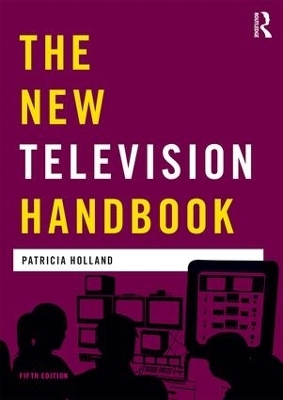
The New Television Handbook
Routledge (Verlag)
978-1-138-83351-7 (ISBN)
This title discusses key skills involved in television production, including: producing, production management, directing, camera, sound, editing and visual effects. Each of these activities is placed within a wider context as it traces the production process from commissioning to post-production.
The book outlines the broad political and economic context of the television industry. It gives an account of television genres, in particular narrative, factual programmes and news, and it considers the academic discipline of media studies and the ways in which theorists have analysed and tried to understand the medium. It points to the interplay of theory and practice as it draws on the history of the medium and observes the ways in which the past continues to influence and invigorate the present.
The New Television Handbook includes:
contributions from practitioners ranging from established producers to new entrants;
a comprehensive list of key texts and television programmes;
a revised glossary of specialist terms;
a section on training and ways of getting into the industry.
By combining theory, real-world advice and a detailed overview of the industry and its history, The New Television Handbook is an ideal guide for students of media and television studies and young professionals entering the television industry.
Patricia Holland has worked as an independent filmmaker, a television editor and a freelance journalist. She is currently a writer and researcher specialising in television history, and lectures at Bournemouth University, UK. Her most recent book is Broadcasting and the NHS in the Thatcherite 1980s (2013). She is the author of the first and second editions of The Television Handbook.
Figures
Acknowledgements
Introduction
Part 1
ON Television and Television studies
1 Television and tele-literacy
Television today
Tele-literacy
2 The history of television in the UK
Conditions of possibility
History of television in UK
3 The Contemporary Landscape: UK channels and public service
The three ages of television
The BBC and its future
Commercial UK broadcasters and public service
Ofcom and regulation
Other UK-based channels
Independent Production Companies
Kate Beal: Woodcut Media
4 The Contemporary Landscape: globalisation, multi-channel and multi-platform
Globalisation and multi-channel
Online and multi-platforrm
5 The landscape of television in the United Kingdom: text
The age of superabundance: interstitials and paratexts.
The linear flow: scheduling and branding
Cross-platform, paratexts and interactivity
About genres
Overview of the main television genres
A note on ratings, funding and formats
6 Studying televison
Studying television: an overview
Mapping the field:
Production/Institution
Theorising media power
Texts: theorising flow and overflow
Audience/Reception
Part 2
THE PRACTITIONERS’ PERSPECTIVE
7 Working in television: an overview
Working in television
Programme production types
Production processes
Television work areas
8 Producing, production management and pre-production
Producers
Production management
pre-production
the production period
post-production
distribution
Abigail McKenzie: Talent Team Assistant BBC Children’s
9 Director, cinematographer and the visual dimension
Director and crew
The director's concerns
Types of shot
A fresh perception of the world
10 The visual dimension: cameras, lighting and the cinematographer
Cameras and recording media
Cameras and digital cinematography
Visions of light
Lighting: basic principles
11 Sound recording and the audio space
Television and the flow of sound
Sound recording and audio design
Sound quality
12 Studios and studio work
‘Live’ and ‘as live’
Working in the studio
Studios
QVC: the shopping channel
13 Post-production processes: editing
Editing and post-production
The work of editing
Editing processes
Styles of editing
The final stages
14 Sound, visual effects and preparing for broadcast
The aural dimension: creating the audio space
Sound editing
Graphics and visual effects
Post-production: preparing for broadcast and distribution
Luke Sothinathan: VT technician
Part 3
PROGRAMMES AND GENRES
15 Drama and Television Narrative
Thinking about narrative
Fictional narratives: drama
Narrative theory
Narrative realism and other realisms
Identity and narration
16 From Documentary to Factual Entertainment
Contemporary factual programming
Brief history of UK documentary
Documentary and contemporary sub-genres
Research for factual programmes
Interview techniques
Documentary and factual ethics
Anne Parisio: Parisio Productions
17 News, politics and television as information
Lisette Johnston
History
Types of news and current affairs
Television news teams
The news agenda
Producing the news
Gio Ulleri Journalist/filmmaker
PART 4
TRAINING AND INDUSTRY CONTEXTS
18 Training, education and getting into the industry
Training and getting into the industry
RedBalloon and Solent Productions
19 Opening up the industry: diversity and access
Diversity and access
MAMA youth project
Bob Clarke: Executive producer MAMA youth project
Jonny Yapi- My Story
Training and opportunities: list of useful references
20 Hannah’s Diary
Hannah Mellows: Office assistant/runner
Contacts for entry-level jobs
21 Making Programmes: Pitching and Commissioning
Turning an idea into a commission
Opportunities and funds
Glossary
Bibliography
Programme references
Index
| Erscheinungsdatum | 24.05.2016 |
|---|---|
| Reihe/Serie | Media Practice |
| Zusatzinfo | 40 Halftones, black and white |
| Verlagsort | London |
| Sprache | englisch |
| Maße | 174 x 246 mm |
| Gewicht | 666 g |
| Themenwelt | Kunst / Musik / Theater ► Film / TV |
| Kunst / Musik / Theater ► Theater / Ballett | |
| Sozialwissenschaften ► Kommunikation / Medien ► Medienwissenschaft | |
| ISBN-10 | 1-138-83351-7 / 1138833517 |
| ISBN-13 | 978-1-138-83351-7 / 9781138833517 |
| Zustand | Neuware |
| Haben Sie eine Frage zum Produkt? |
aus dem Bereich


